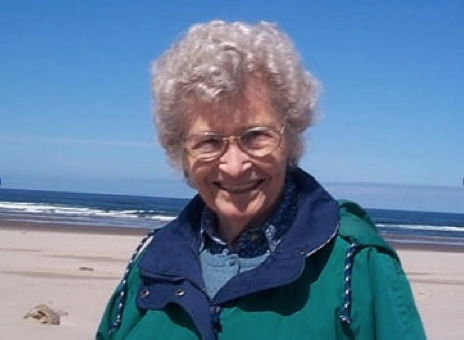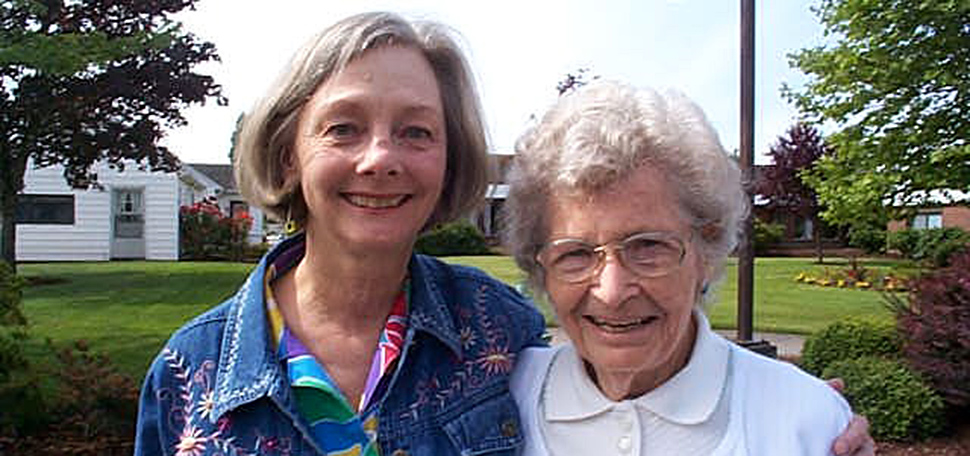Update: the Elizabeth Whitefield End of Life Options Act went into effect on June 18, 2021.
Adrienne Dare is a retired college professor in Silver City, New Mexico. She shared her story with us in 2015; on September 5, 2020 she added an update.
Eighteen Years of Comfort

Today is the 5th of September 2020 and I am celebrating the 18th anniversary of my mother, Louise Hall, using Oregon’s Death with Dignity Act to end her suffering with terminal cancer.
She was comforted knowing I would be there to help take care of things. I cried when I actually heard Mom tell her doctor in her first verbal request for medical aid in dying that she was ready to die. Mom said to the Doctor “You won’t get in trouble, will you?”
This was a very profound and positive experience. This was what Mom wanted. The best part is that she was no longer in pain. The fact that Mom was able to have this choice has brought much comfort to me for the last 18 years.
Because of my experience with my Mom in Oregon my passion for this issue has led me to be active since 2012 to work on passing our Elizabeth Whitefield End of Life Options Act in New Mexico.
(September 2020)
A Diagnosis And a Practice for Last Words
In 2002 my 90-year old mother was diagnosed with terminal cancer. She underwent radiation to try to reduce the tumor, but had to stop the treatment because it was too painful. But even after she was on hospice her pain couldn’t be controlled with medication.
I was able to be with her in Albany, Oregon, for her last two months. She was a quiet, shy, private person who didn’t like to talk about herself. But the pain medications changed her and she became very talkative. She even talked in her sleep, repeating, “I love you, I love you all,” as if she were practicing because it wasn’t something that came easy for her to say.

We shared intimate conversations. There were some very special moments, too. She shared with me a letter she’d written to my father, exclaiming she’d never been as happy as then in her life. And she gave me an onyx heart, which father gave her when they married and which I’d never seen. I asked about the damaged portion of it, and she told me I’d teethed on it.
Ready to Die
It was clear Mom was ready to die. She went to the doctor and made her first oral request for death with dignity. Hearing that made me cry but I knew that’s what she wanted. “Adrienne, don’t cry, I’m alright,” she told me. Two weeks later she said she couldn’t stand the pain anymore and went back to the doctor to make the second request (she also filled out the written request form).
On September 5, 2002, my brother and I and our spouses gathered in her bedroom. Her minister asked Mom if she wanted a prayer. Mom said no. She was really ready to end the pain. However she still had a sense of humor. When my sister-in-law told Mom, “Thank you for giving me Tim (my brother),” Mom replied, “Thank you for taking him.” In the end, she told us, “I love you all,” drank the water with the dissolved medicine, and died peacefully within a few minutes. She even had a little smile on her face.
A Profound Experience
It was a profound, positive experience. Best of all, she was no longer in pain. Since that day I have been comforted that she was able to die peacefully at home surrounded by family. It was what she really wanted. I’ve read many stories of people who wanted to die but couldn’t, including people who killed themselves with guns. I am so thankful that Mom was able to die this way.

In our society, we need to talk about death. We should have those difficult conversations before death becomes an emergency. I also believe death with dignity should be available for any terminally ill, competent adult so they can end unbearable suffering at the end of life. It not only relieves the dying person of more suffering but also gives great comfort to the family and friends.

